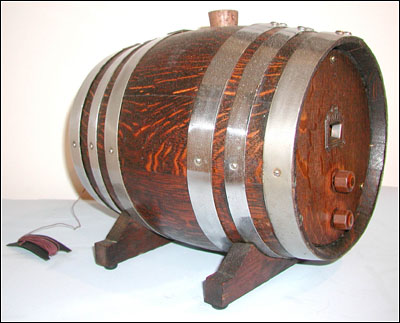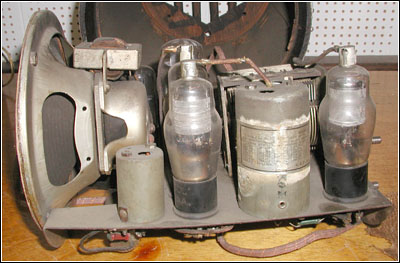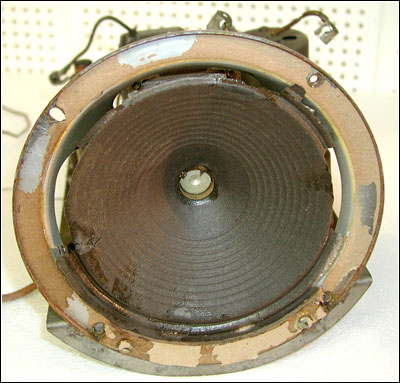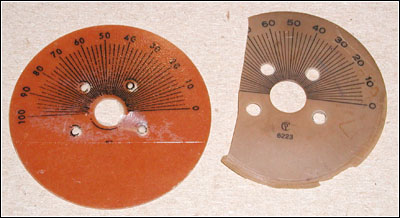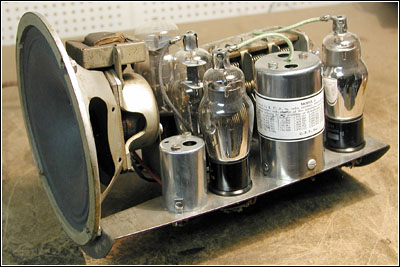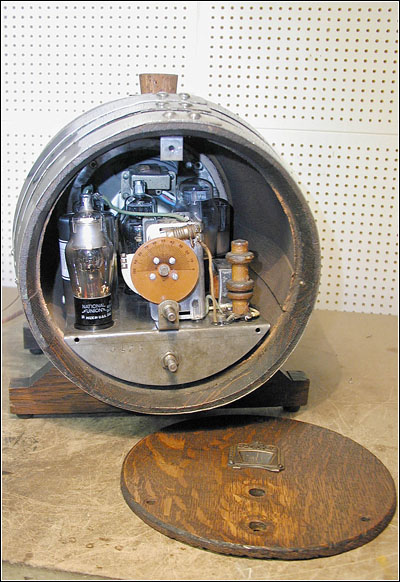Of Old Radios And Related Items--Published Monthly
Radio Keg Model 6 -- A Barrel of Fun
BY RAY BINTLIFF, W1RY
Web Edition
In the July 2006 issue of A.R.C., Ray wrote about a novelty radio housed in an oversized Pepsi bottle. This time, he describes the restoration of a radio contained in a scaled-down beer keg. (Editor)
Novelty radios gained popularity in the 1930s and were offered by a number of manufacturers. I suppose that radios with a theme, such as the Snow White, Mickey Mouse, Worlds Fair and similar models could be classified as novelty radios. But, those sets looked like radios. So, for this article I will mention radios that were made to look like something other than a radio.
To my mind, the Pepsi Bottle radio is a classic example of a novelty radio. Some other novelty radios of note include the Porto Baradio, the Treasure Chest models from Majestic and American Bosch, and the Trophy Baseball, a 1941 model. A.R.C. readers can probably reel off the names of many other examples.
My favorite, and the subject of this article, is the Radio Keg Model 6 manufactured by R. K. Radio Laboratories in Chicago and shown in Figure 1.
Figure 1. The R.K. Radio Laboratories Radio Keg Model 6.The Radio Keg Model 6
A 1933 model, the Radio Keg 6 is an AC/DC, 5-tube superhet with a 175 kHz IF. The tube complement consists of the following types: a 6C6 mixer-oscillator, a 6D6 IF amplifier, an 85 detector 1st AF, a 43 AF output and a 25Z5 rectifier. A resistance line cord is used to drop the line voltage for the series-string filaments. The radio employs a 61/2" electrodynamic speaker and a separate filter choke.
A schematic diagram for the radio can be found on Miscellaneous Page 4-9 of Rider's Volume IV. That page credits the radio to "Clago Radio Corp., RK Radio Laboratories, Inc."
The keg is 12 inches in length, and the ends measure 83/4 inches in diameter. Just like a full sized keg, it is made of oak staves and metal hoops and features chrome-plated hoops.
Figure 3. A side view of the radio in "as-found" condition.As Found
Though I had been hoping for a radio that could be easily repaired, what I really bought was a radio in need of restoration. The speaker cone was badly damaged and the dial scale was broken. The radio had some previous "repairs" of questionable quality. Rust and corrosion were apparent, along with the usual dirt and dust.
Mercifully, the keg cabinet was in good condition, except for some missing hardware and crumbling rubber feet. The knobs may not be original, but judging from the wear marks on the front panel, they must have been there for a long time.
Figure 2 (see print version) shows the keg and a bottom view of the chassis in its "as-found" condition. Most components were original. However, a replacement electrolytic filter capacitor had been added, though the original filter capacitor had not been disconnected. Not a good practice. Figure 3 shows a side view and Figure 4 (see print version) provides a front view. Note the broken dial scale -- more about that below. As Figure 5 shows, the speaker was just begging for a new cone.
Figure 5. The speaker cone needed repair.Restoration
As the first step, I replaced all capacitors and resistors. Axial-lead, tubular, electrolytic capacitors were hidden in a replicated cardboard box. Next, all bad wiring, including grid leads, was replaced or repaired with heat shrink tubing. All rubber grommets had turned rock hard and were replaced, including the tuning capacitor mounts shown in Figure 6 (see print version).
Figure 7. On the left is the replica dial scale; on the right is the original broken one.Dial Scale Replication
The major challenge in the restoration process was replacing the broken dial scale. The diameter of the replacement dial is critical since the dial is part of the rim-drive tuning mechanism that drives the variable capacitor. For that reason, it was unlikely that I could find a stock replacement of the exact size. So, fabricating a new dial seemed to be the only way to go.
Making a blank dial of the correct diameter was easily done on a lathe using plastic sheet stock. OK, but what about the scale markings and numbering? Welcome to the wonderful world of computers.
Figure 9. The restored chassis, right side view.I scanned the broken dial and used "Paint" software to add the missing dial markings. Again OK, but how could I transfer the new dial markings to the blank dial material? The cost of silk-screening a "one-off" dial was prohibitive. The answer was a product called "Toner Transfer System" that can be used to make decals.
I made a number of decals just in case I screwed up. And I did, but finally got a decal applied to the blank dial. Figure 7 shows the reproduction and broken original dials. For information on the Toner Transfer System go to www.pulsar.gs.
Figure 11. The restored radio showing how the radio chassis fits inside the keg.The Finale
Figure 8 (see print version) shows a bottom view of the restored chassis, and two top views of the finished radio, are shown in Figures 9 and 10 (see print version). Figure 11 shows the chassis stuffed into the keg cabinet and ready for installation of the front panel. So much for the easy repair I had hoped for, but the restoration effort was worth it. It is an unusual radio that looks great and works like new.
Reference:
Rider, John F. Perpetual Troubleshooter's Manual, Volume IV, Miscellaneous, pp. 4-9. New York: John F. Rider Co. Year 1934.
Ray Bintliff, a frequent contributor to A.R.C and a member of its staff, holds an Amateur Extra Class license. A retired engineer, he enjoys repairing and restoring pre-1945 radios and test equipment. In addition to Amateur Radio, his interests include electronic equipment and
|
[Free Sample] [Books, etc., For Sale] [Subscribe to A.R.C./Renew] [Classified Ads] [Auction Prices] [Event Calendar] [Links] [Home] [Issue Archives] [Book Reviews] [Subscription Information] [A.R.C. FAQ]URL = http://www.antiqueradio.com/Aug08_Bintliff_RadioKeg.html Copyright © 1996-2008 by John V. Terrey - For personal use only. Last revised: July 31, 2008. For Customer Assistance please contact ARC@antiqueradio.com or call (866) 371-0512 toll free Pages designed/maintained by Wayward Fluffy Publications Antique Radio Classified |
